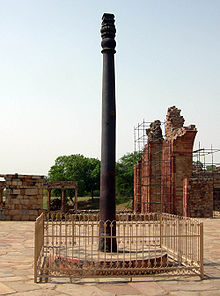Iron pillar of Delhi
Appearance

The iron pillar of Delhi is a 7 m (23 ft) kirti stambha (column of fame or victory column), originally erected and dedicated as dhvaja (banner) to Hindu deity lord Vishnu in the 3rd to 4th century CE by king Chandragupta II, currently standing in the Qutb complex at Mehrauli in Delhi, India. It is famous for the rust-resistant composition of the metals used in its construction.
Quotes
[edit]- (Verse 1) He, on whose arm fame was inscribed by the sword, when, in battle in the Vanga countries (Bengal), he kneaded (and turned) back with (his) breast the enemies who, uniting together, came against (him);-he, by whom, having crossed in warfare the seven mouths of the (river) Sindhu, the Vahlikas were conquered;-he, by the breezes of whose prowess the southern ocean is even still perfumed;-
(Verse 2) He, the remnant of the great zeal of whose energy, which utterly destroyed (his) enemies, like (the remnant of the great glowing heat) of a burned-out fire in a great forest, even now leaves not the earth; though he, the king, as if wearied, has quit this earth, and has gone to the other world, moving in (bodily) from to the land (of paradise) won by (the merit of his) actions, (but) remaining on (this) earth by (the memory of his) fame;-
(Verse 3) By him, the king, attained sole supreme sovereignty in the world, acquired by his own arm and (enjoyed) for a very long time; (and) who, having the name of Chandra, carried a beauty of countenance like (the beauty of) the full-moon,-having in faith fixed his mind upon (the god) Vishnu, this lofty standard of the divine Vishnu was set up on the hill (called) Vishnupada.- Inscription on Iron Pillar, J. F. Fleet's 1888 translation. R. Balasubramaniam (2005). Story of the Delhi Iron Pillar. Foundation Books. ISBN 978-81-7596-278-1.
- The art of tempering and casting iron developed in India long before its known appearance in Europe; Vikramaditya, for example, erected at Delhi (ca. 380 A.D.) an iron pillar that stands untarnished today after fifteen centuries; and the quality of metal, or manner of treatment, which has preserved it from rust or decay is still a mystery to modern metallurgical science. Before the European invasion the smelting of iron in small charcoal furnaces was one of the major industries of India. The Industrial Revolution taught Europe how to carry out these processes more cheaply on a larger scale, and the Indian industry died under the competition. Only in our own time are the rich mineral resources of India being again exploited and explored.
- Will Durant, Our Oriental heritage [1]
- Iron Pillar: “…In our opinion this pillar was made in the ninth century before (the birth of) Lord Jesus… When Rai Pithora built a fort and an idol-house near this pillar, it stood in the courtyard of the idol-house. And when Qutbu’d-Din Aibak constructed a mosque after demolishing the idol-house, this pillar stood in the courtyard of the mosque… ”Idol-house of Rai Pithora: “There was an idol-house near the fort of Rai Pithora. It was very famous… It was built along with the fort in 1200 Bikarmi [Vikrama Samvat] corresponding to AD 1143 and AH 538. The building of this temple was very unusual, and the work done on it by stone-cutters is such that nothing better can be conceived. The beautiful carvings on every stone in it defy description… The eastern and northern portions of this idol-house have survived intact. The fact that the Iron Pillar, which belongs to the Vaishnava faith, was kept inside it, as also the fact that sculptures of Kirshan avatar and Mahadev and Ganesh and Hanuman were carved on its walls, leads us to believe that this temple belonged to the Vaishnava faith. Although all sculptures were mutilated in the times of Muslims, even so a close scrutiny can identify as to which sculpture was what. In our opinion there was a red-stone building in this idol-house, and it was demolished. For, this sort of old stones with sculptures carved on them are still found.
- Syed Ahmed Khan: Asaru’s-Sanadid. About antiquities of Delhi. Translated from the Urdu of Asaru’s-Sanadid, edited by Khaleeq Anjum, New Delhi, 1990. Vol. I, p. 305-16
- Shams-i Siraj Afif (d. 1388), in the mid-fourteenth century, explained Iltutmish’s motives regarding the pillar,
Every great king took care during his reign to set up some lasting memorial of his power. So sultan Shams al-Din Altamash raised the large pillar in the Masjid-i Jami at old Dehli.- (Elliot and Dowson Vol. Il: 353). in Jain, M. (2019). Flight of deities and rebirth of temples: Espisodes from Indian history. 60
- As regards the dhanus of 1.9 m, which I calculated at Dholavira, R. Balasubramaniam showed in a recent study that in combination with an angula of 1.76 cm, it expressed all the dimensions of the Delhi Iron Pillar with unexpected harmony: the pillar’s total length of 7.67 m, for instance, is precisely four dhanus; the pillar’s diameter, thirty-six angulas at the bottom, shrinks to twenty-four angulas at ground level, finally to taper off at twelve angulas at the very top. If this were not enough, the ratio between the pillar’s entire length (7.67 m) and the portion above the ground (6.12 m) is 5:4, verified to 0.2 per cent—again, Dholavira’s master ratio! This bears out what we have already concluded from the texts : Harappan ratios and linear units survived the collapse of the Indus cities and passed on to those of the Ganges Valley.
- in Danino, M. (2010). The lost river : on the trail of the Sarasvatī. Penguin Books India.

